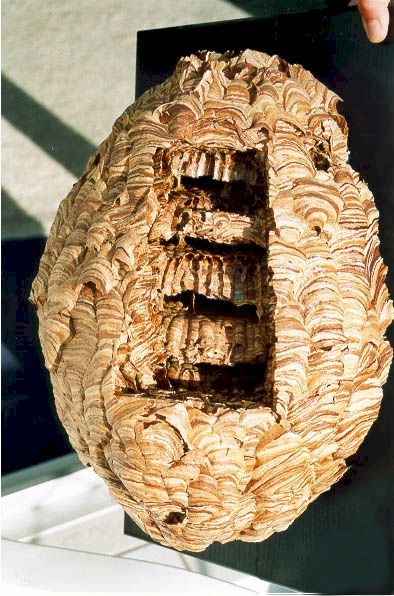
Holes in the ground. The first thought that comes to mind when thinking about a wasp or hornets nest is an ugly papery nest hanging in a tree but most ground hornet nests hide underground.

Because of their size hornets have a louder humming than wasps.
Where do hornets nest. Like common wasps hornets build their nests out of paper in hollow trees chimneys wall cavities and sheds etc. Sometimes they use the same site year after year although the same colony may not use the same site as the previous colony. Because of their size hornets have a louder humming than wasps.
They also have a reputation of being quite aggressive and constantly angry insects. Bald-faced hornets nest in trees or large bushes at least three feet from the ground. The pests may also hang their nests from the eaves and roofs of buildings.
A bald-faced hornet hive is egg-shaped and can be up to two feet in length. Overhangs and soffits are typical sites for this kind of hornet nests. The largest of the British social wasps they build papery nests in hollow trees although hornet nests have been discovered in wall cavities and chimneys.
The hornets life cycle is similar to that of the common wasp. Newly-mated queens hibernate during the winter and emerge in spring to begin building a nest. They lay eggs that hatch into sterile female workers who take over nest building and collecting.
How Do Bald Faced Hornets Build Their Nests. The bald-faced hornet nest is started by the queen in the early spring. She will find soft rotted wood to chew up.
Once she creates a chewed cellulose mixture she will form small paper cylinders that make up the entire nest. Each compartment will provide adequate housing for an egg larvae or adult worker wasp. The workers can expand the nest.
Wasps are very well adapted and are able to construct nest in a large range of habitats. Examples of nest locations include. In trees including both free hanging nests or inside tree stumps.
In houses including inside wall cavities lofts and fascia boards. Holes in the ground. The Oriental hornet V.
Orientalis occurs in semidry subtropical areas of Central Asia Armenia Dagestan in Russia Iran Afghanistan Oman Pakistan Turkmenistan Uzbekistan Tajikistan Kyrghyzstan southern Kazakhstan and southern Europe Italy Malta Albania Romania Turkey Greece Bulgaria Cyprus. Hornets nest in the ground Asides from high places hornets are also known to build their nests in enclosed spaces that provide support and security. Sometimes this can be old abandoned rodent burrows.
Located within fields gardens and parks hornets that build their nests in the ground cause a real risk to humans. The hornet queen starts the hives nest. She uses her mandibles to scrap away pieces of wood fiber from any available source.
The scrapings are then broken down by a mixture of saliva and water inside the queens mouth. There is a familiar and sometimes terrifying buzz that comes with a nest of hornets. It is a sound no homeowner wants to hear.
These pests can set up with nests in the attic in the eaves of your house in a nearby tree or in just about any covered area. Hornets build their nests in outdoor areas and usually high above ground such as in trees on a utility pole or in thick shrubs. They will also build nests on the eaves of roofs and under decks.
Often you wont see their nest until autumn when the leaves fall off and reveal the nest hidden within. Hornet nests are small and easier to remove in the early spring. A nest thats around the size of a ping pong ball probably only contains a queen and unhatched eggs so you can just spray it down with a hose.
Youll need insecticide to get rid of a larger nest. By summer nests can grow to the size of a basketball and contain thousands of hornets. European hornets usually build their nests in cavities around your home like in trees or walls while bald-faced hornets usually make aerial nests in.
We recommend keeping your eyes open in case the next has bald-faced hornets or yellowjackets. Yellowjackets typically build their nests in cavities either within walls or beneath the ground. If the wasps look like theyre coming in and out of a small hole they are most likely yellowjackets.
Hornets wasps and yellow jackets produce nests that are slightly different from one another. Most yellow jackets construct their papery nests underground in rodent burrows or other holes. However some German yellow jackets Vespula germanica occasionally nest inside the walls of buildings.
Aerial yellow jackets Dolichovespula spp and European hornets Vespa spp construct similar nests usually. The first thought that comes to mind when thinking about a wasp or hornets nest is an ugly papery nest hanging in a tree but most ground hornet nests hide underground. If you notice a flurry of hornet activity around your home but cannot locate the nest its probably in your lawn.
Discover how to get rid of ground hornets using a variety of solutions and techniques. Unlike most other stinging insects ground hornets tend to be more solitary. They build their nests nearly anywhere ranging from backyards sidewalks gardens and more.
Once their burrowing process begins they create nesting sites. These nesting sites can be a whopping foot and a half deep below ground surface. Photo by Nathanial Walton MSU Extension.
Wasps and hornets often create their nests in areas that interfere with our daily human travel such as building a paper nest under a house eave. If they feel threatened hornets and wasps will defend their territory by repeatedly stinging.